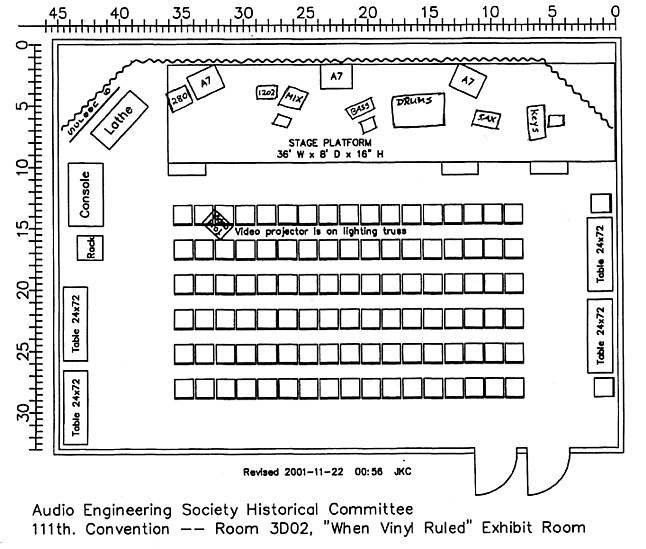
Return to Direct-to-Disc page one
This is the floor plan of the exhibit room at the Javits Convention Center (courtesy of John Chester) with the approximate positions of the musicians and myself added:

As you can see, I was onstage with the musicians, no more than 6 feet from the bass amp. I had no choice but to monitor on headphones, preferably ones with exceptionally good isolation. Note also the position of the sax between the drums and keyboard setup. To obtain any isolation of the sax at all required a microphone with very good side-rejection. I ended up using a bi-directional ribbon microphone, with the null points of the figure-8 pattern placed to reject the drums and keyboards.
The squiggly line in back of the stage area represents curtains which were hung to control the acoustics a bit. In fact, the acoustics were not too bad, but air conditioning rumble was quite audible, and the room was just off the main floor of the convention, which was quite a noisy place. The necessity for close miking of the musicians was clear.
My original block diagram of the recording setup, in magnificent #2 pencil:

The custom built all-tube mixer was lent to us by Walter Sear, hence the designation "Sear mixer". It had only 12 inputs, 2 of which were reserved for reverb returns. It also had only 2 output busses, which were used for the main stereo mix. There were individual sends for reverb on each channel, but they went to individual XLR jacks on the back of the mixer - there was no reverb send bus. Therefore, I used a Mackie 1202 VLZ-PRO as a submixer for the signal sent to the AKG BX-20 reverb.
The BX-20 is a spring reverb, but a very sophisticated one, with multiple spring elements enclosed in a large wooden case about 4 feet high. It sounded better than any other spring reverb that I have ever heard; indeed, most mechanical plate reverbs do not sound as good. Only the best present-day digital reverbs are superior to it.
As the Sear mixer had no provision for monitoring, I listened to my mix as follows: the stereo mix went to the Neumann console, then to the Scully 280 backup recorder, and I sent the output of the Scully to another 2 inputs of the Mackie 1202. I could then monitor the stereo mix through the entire recording system using the alt-3-4 bus of the Mackie. The headphones were the Remote Audio HN-7506. These are special headphones built by Glenn Trew in Nashville. Glenn takes the drivers from Sony 7506 headphones and installs them in high-isolation ear protectors. (You've seen similar ear protectors worn by airport tarmac workers.) Putting the 7506 drivers in a different environment did change how they sound a bit, but it was close enough that I could still mix effectively, and the extra isolation was most welcome.
My input list form, actually used as intended:

Audio Engineering Associates was exhibiting at the convention, and they lent us a beautifully restored RCA 44-BX ribbon microphone which I used on the tenor sax. (You can see it in the band photo on the previous page.) Designed in the mid-1930's by Harry Olson, the 44-BX is known for its smooth treble response and excellent pattern control. It is also sufficiently heavy to pull a normal microphone boom stand right over, so we used a large roll-around studio stand for this mic.
Whirlwind kindly lent us one of their direct boxes, which we used on the bass. In addition, I miked the bass amp with an EV-RE 11, a supercardioid dynamic element mic. The purpose of miking the amp is to pick up its tonal colorations, which the bass player uses as an element of his sound. However, the fundamental tones of the instrument are not well reproduced by a microphone mere inches from a speaker driver, so the direct pickup is mixed in for that purpose.
The Advent MDC-1 listed for the kick drum is a dynamic cardioid microphone, built for Advent in the 1970's by Beyer Dynamic. Henry Kloss marketed the MDC-1 in matched pairs for use with the Advent cassette recorder. The MDC-1 has a fairly smooth overall response with a mild bass roll-off built in. I have found that it sounds good on percussion, and is a viable alternative to such mainstays as the Shure SM-57, etc.
The Schoeps microphones used for drum overheads were small diaphragm tube condensers, lent to us by Jerry Bruck of Posthorn Recording. As Walter Sear's mixer did not provide phantom power, the separate power supplies required for these vintage Schoeps microphones were not a disadvantage. I have not seen any spec sheets for these mics, but they sounded very smooth and well balanced, as one would expect given Schoeps' reputation. Most of the drum sound was picked up by these microphones, which were hung over the drum set in a quasi-ORTF setup. The idea was to pick up the sound of the drums in stereo perspective, while avoiding strong out-of-phase information in the bass, which could cause problems with the disc cutting. For the same reason, the kick drum mic was panned to dead center in the stereo mix, ensuring that its output would cause only lateral motion of the disc cutting stylus.
Return to Direct-to-Disc page one
Return to Robert Auld Homepage
This page copyright 2002, Robert Auld